Uranus
534-547
In many ways Uranus is an "under whelming" planet. Discovered by Herschel in 1781, it is featureless in even a large telescope. Figure 18.20 shows a Voyageur 2 image from 1986. Not much to see! But - this belies some fascinating oddities that set Uranus apart from other planets. Uranus' orbital inclination is 97.9 degrees - it is tipped sideways compared to the Earth and the other planets. As well, its strong magnetic field is not at all lined up with the planet's rotational axis. Welcome to Uranus.
Basic Facts
|
 |
||||||||||||||||||||
| Figure 18.20 Voyageur 2 image of Uranus in 1986. (image courtesy NASA) | |||||||||||||||||||||
The Interior and Atmosphere
Uranus has only 1/20 th the mass of Jupiter and thus is unable to produce the pressures needed to create metallic hydrogen in its interior. The density of the planet suggests, however that it may well have a rocky core. As well, rotation and oblateness measurements suggest that there may be a deep mantle layer of solid water. The atmosphere is mostly composed of hydrogen and helium but traces of ammonia and methane give the planet is distinct, pale blue colour. Figure 18.21 depicts the structure of Uranus. At a distance of nearly 20 AU, Uranus receives little warming energy from the Sun and is a cold world with cloud top temperatures a frigid 55 K or -228 C. at these temperature there is little atmospheric circulation and hence the planet shows very little (if any) cloud activity. |
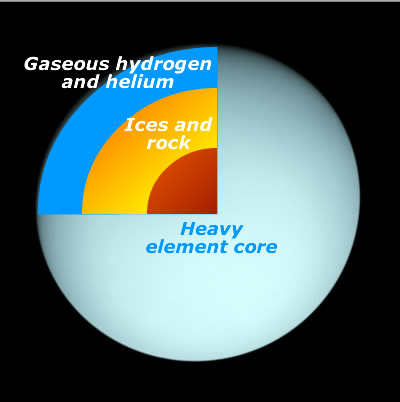 |
| Figure 18.21 Internal structure of Uranus |
Uranus' Odd Orbital Inclination
Figure 18.22 compares the earth's 23.4 degree inclination with an inclination of 97.9 degrees for Uranus.
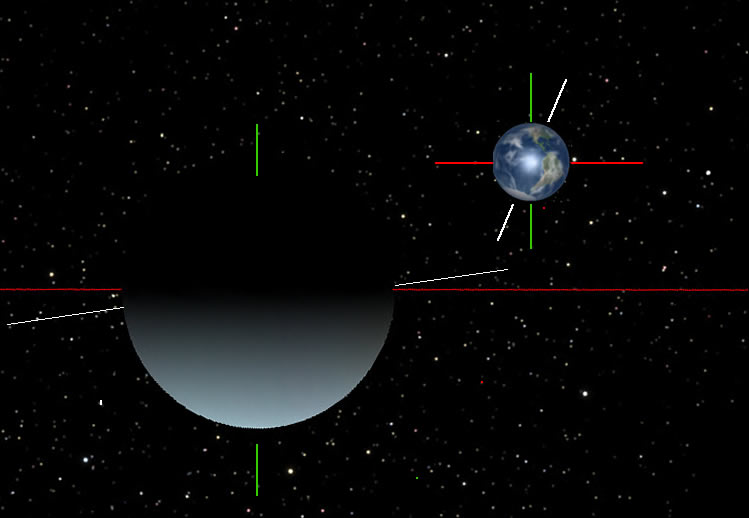 |
| Figure 18.22 The orbital inclination for Uranus and Earth |
Example 18.7 Explain how seasons on Uranus would be very different than seasons on Earth.
Solution:
| Summer and Winter would be very long seasons! In "northern" summer on Uranus the Sun would not set for 21 years! If you were at the pole the Sun would appear almost stationary in the sky. As you move toward the equator the sun would move in an increasingly large circular path but no where dip below the horizon. Figure 18.23 shows a video clip of the path of the sun over approximately 3 Earth days. | |
| Figure 18.23 |
The Magnetic Field on Uranus
 |
Uranus has a large magnetic field that is not only tipped by about 58 degrees with respect to its rotational axis but is also offset by about the 1/3 the radius of the planet. It is quite likely that the magnetic field is produced by convective motions much closer to the surface of the planet and not in the central core as it is in the Terrestrial planets and Jupiter and Saturn.
|
| Figure 18.24 Uranus' offset magnetic field |
Uranus' Moons and Ring System
Figure 18.25 show the ring system around Uranus along with the numerous "shepherd moons". This is very similar to the Saturnian ring system. As well, the material that makes up the rings around Uranus is similar to that of Saturn's ring material and is likely being continually replenished by debris from impacts on the Uranian moons.
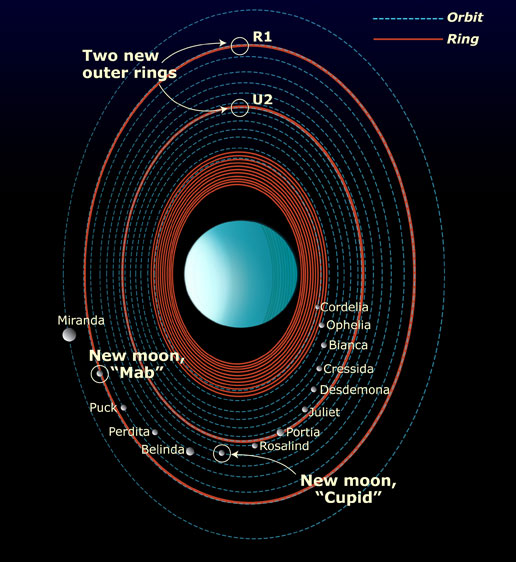 |
Miranda and Ariel Uranus' retinue of moons includes the major moons Miranda and Ariel. Although both moons are heavily cratered, they do also have some areas on their surfaces that suggest recent geologic activity. Although Ariel is heavily cratered there are some regions with broad valleys with few craters and suggest that flooding - possibly by water occurred in the recent past. Miranda, also heavily cratered, shows curious folds or ridges called ovoids. These are believed to have been caused by convection in the planet as it cooled. Figures 18.26 and 18.27 show Miranda and the ovoids. |
| Figure 18.25 The Uranian ring system. (Image courtesy NASA) |
Example 18.8 Figure 18.27 is a close up of the ovoids on the surface of Miranda. Note that they are heavily cratered. Does this suggest that the ovoids have formed recently or in the distant past?
Solution: The craters must have formed after the ovoids hence the ovoids are likely an old feature on the moon and it is likely that Miranda is no longer geologically active.
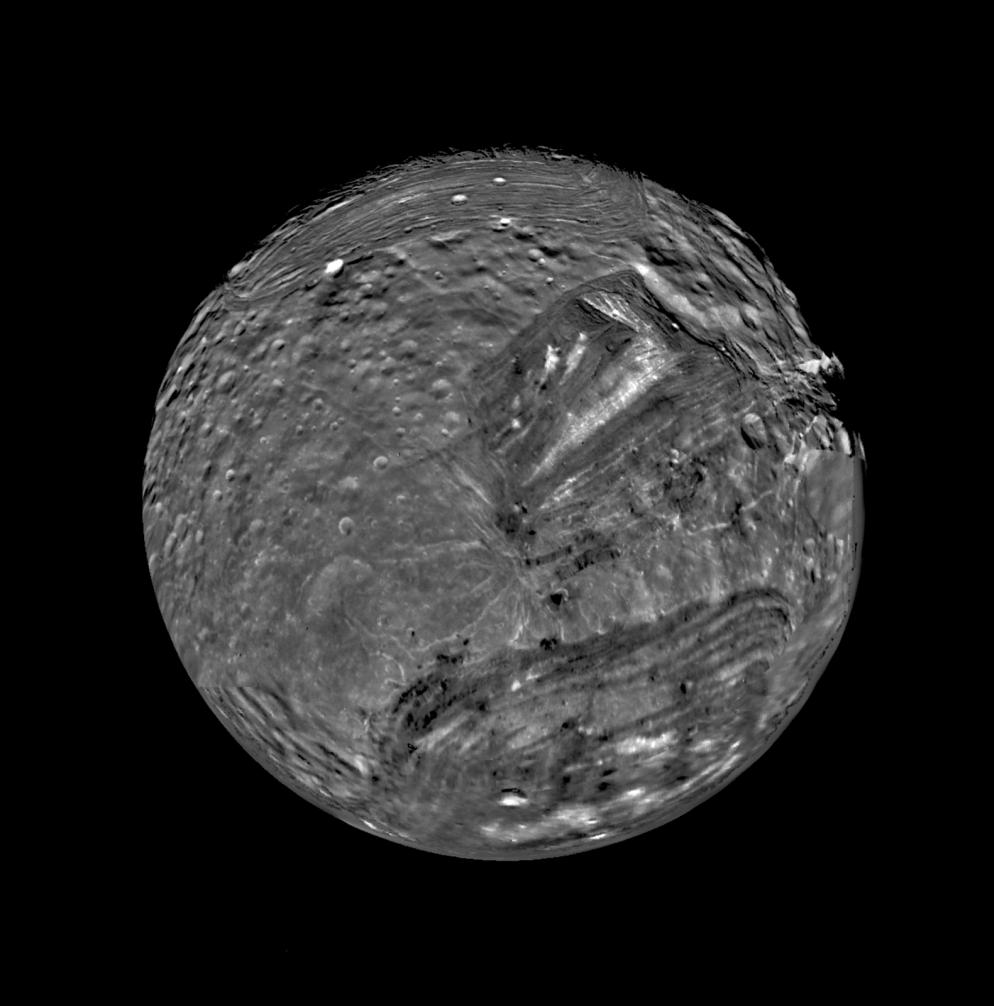 |
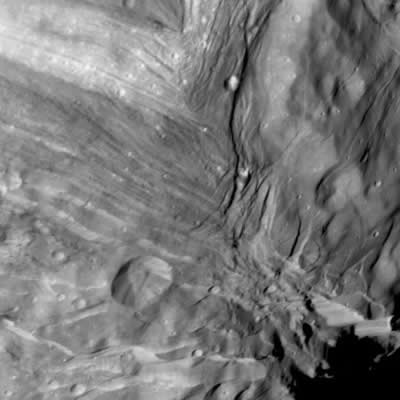 |
| Figure 18.26 Miranda as seen by Voyageur 2 in October 1998 (Image courtesy NASA). | Figure 18.27 Ovoids on the surface of Miranda (Image courtesy NASA). |
Practice
- Why is it unlikely that Uranus contains metallic hydrogen in its interior?
- Explain why it could be argued that a summer day on Uranus lasts the entire summer!
- Why is the atmosphere of Uranus less active than the atmospheres of either Jupiter of Saturn?
- The Roche tidal disruption limit for a satellite is approximately 2.4 times the radius of a planet. Look at Hubble Space Telescope image of Uranus and the ring system Estimate how much of this ring is within the Roche limit.
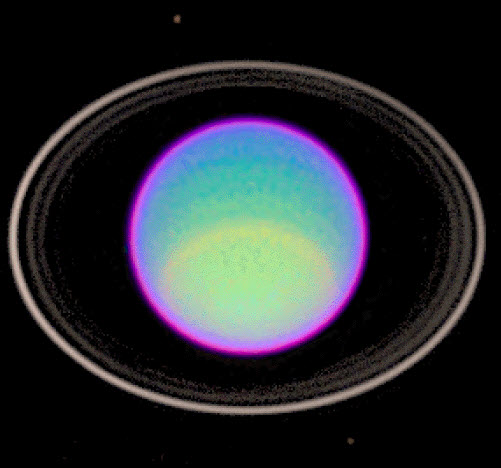 |
| HST image of Uranus, April 1996 (Image courtesy HST/NASA) |

To understand Saturn as an Outer Solar System planet
Chp 24-1
![]()

Remember - densities can be expressed in grams per cubic cm (g/cm3) or in kilograms per cubic metre (kg/m3). To vonvert gtom g/cm3 to kg/m3 multiply buy 1000.
For example, the density of water is 1 g/cm3 or 1000 kg/m3.